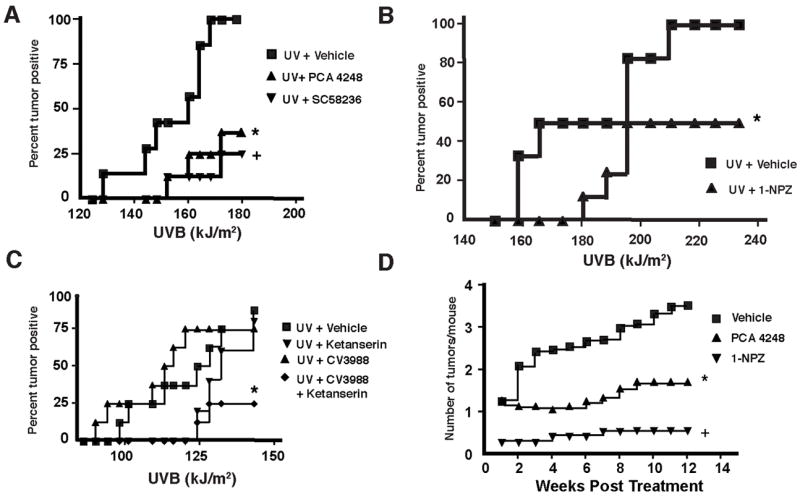Figure 1.

Suppression of skin cancer induction and progression by PAF and serotonin receptor antagonists. A. PAF receptor antagonist suppresses skin cancer induction. Hairless mice were exposed to 1.25 kJ/m2 of UVB radiation on Mondays, Wednesday and Fridays. 1 hr prior to irradiation, the mice received an ip injection of PCA-4248 or a selective COX-2 inhibitor (SC58236). * Indicates a significant suppression of tumor incidence vs. the UV + Vehicle control; p <0.02. + Indicates a significant suppression of tumor incidence vs. the UV + Vehicle control; p <0.003. B. 5-HT2A-receptor antagonist suppresses skin cancer induction. Hairless mice were exposed to 1.25 kJ/m2 of UVB radiation on Mondays, Wednesday and Fridays. 1 hr before irradiation, the mice were injected with 1-NPZ. * Indicates a significant suppression of tumor incidence vs. the UV + Vehicle control; p < 0.03. C. PAF and 5-HT2A-receptor antagonists act in concert to block skin cancer induction. Mice were injected (ip) with sub-optimal doses (500 pmol) of CV-3899, a PAF receptor antagonist or ketanserin, a 5-HT2A receptor antagonist, or with a mixture of the two (500 pmol of each). * Indicates a significant suppression of tumor incidence vs. the UV + Vehicle control; p < 0.04. D. PAF and 5-HT2A receptor antagonists block the progression of skin cancer. Mice were exposed to sufficient UV radiation to induce a papilloma, and then they were removed from protocol, and injected with a PAF (PCA-4248) or a 5-HT2A (1-NPZ) receptor antagonist. * Indicates a significant suppression of tumor number vs. mice injected with the vehicle only; p < 0.01. + Indicates a significant suppression of tumor number vs. mice injected with the vehicle only.
